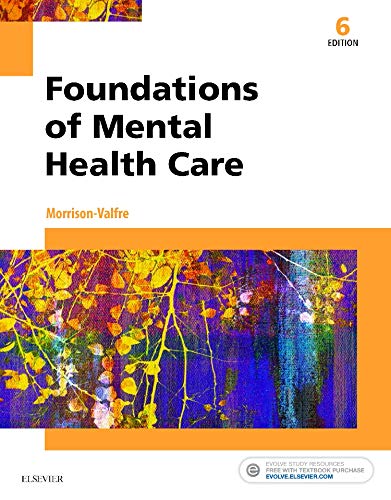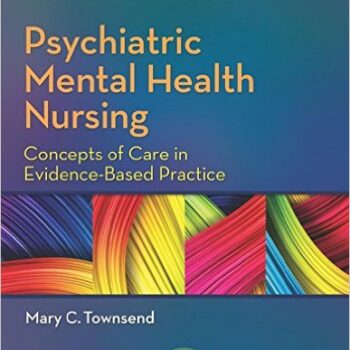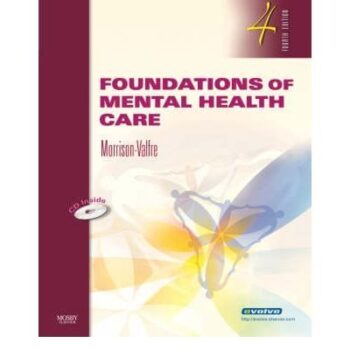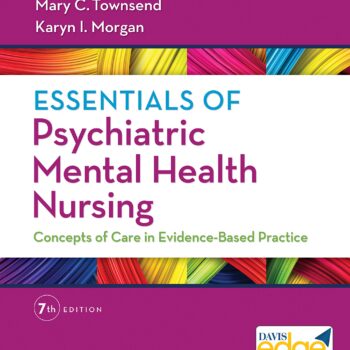
Foundations of Mental Health Care 6th Edition By Morrison Test Bank
Original price was: $55.00.$28.00Current price is: $28.00.
Digital item No Waiting Time Instant DownloadISBN-10: 0323354920 ISBN-13: 978-0323354929Publisher: Mosby; 6th editionAuthor: Michelle Morrison-Valfre RN BSN MHS FNP
A comprehensive understanding of mental health can only be achieved with the correct resources. Morrison’s Foundations of Mental Health Care 6th Edition comprises the most effective knowledge and materials that will assist students and professionals. This test bank is actually resourceful in learning and making sense of the ideas that underline the practice of mental health care today.
Why Choose the Test Bank of the Foundations of Mental Health Care?
The test bank for the Foundations of Mental Health Care 6th Edition is crafted with the sole purpose of aiding you to understand the material at hand. Carefully constructed questions and responses, help you evaluate your understanding of the material and prepare for the examinations appropriately. The philosophy we hold is that practice is the best teacher and this is where this test bank comes in as the perfect learning aid.
Key Features of the Bank of Test
- Comprehensive Coverage: The test bank is not an exception and includes a lot of questions from all the important topics in the Foundations of Mental Health Care 6th Edition which enables you to prepare adequately. This enables you to prepare well.
- Easy to Understand: These are easy-to-understand questions that have been well put in an understandable manner for most people interested in mental health care.
- Supports Your Learning: This test bank can help you enhance your knowledge and boost your self-trust regarding the topics of mental health.
How the Foundations of Mental Health Care Test Bank Can Help You
Studying with the Foundations of Mental Health Care 6th Edition Test Bank gives you so much more than self-instruction. It will allow you to:
- Improve Knowledge Retention: The importance of spaced learning cannot be overemphasized.
- Boost Your Confidence: Your adequate preparedness will help you avoid panic once the time comes for you to take up the challenge.
- Enhance Your Skills: There is a purpose why those questions are included in a test bank – the purpose is to foster thinking skills, very much needed in mental health care practice.
Join the Community of Learners
When you pick the Foundations of Mental Health Care 6th Edition by Morrison Test Bank, you do not simply access a quote. Instead, you become part of a network of learners. Then, we can all be in the community of assertive supporters assisting each other with mental health care ideas and techniques.
Conclusion
Investing in the Foundations of Mental Health Care Test Bank Morrison 6th Edition as an academic source is to come closer to your educational and career objectives. Its features also consider an efficient approach that would enrich your learning and expand your knowledge in the field of mental health and care.
Foundations of Mental Health Care 6th Edition By Morrison Test Bank
Chapter 01: The History of Mental Health Care
Morrison-Valfre: Foundations of Mental Health Care, 6th Edition
MULTIPLE CHOICE
1. The belief of the ancient Greek philosopher Plato that the rational soul controlled the irrational soul could be compared with the belief of the more recent psychological theorist:
|
a. |
Freud |
|
b. |
Pinel |
|
c. |
Fisher |
|
d. |
Rush |
ANS: A
Sigmund Freud believed that mental illness was, in part, caused by forces both within and outside the personality. Philippe Pinel advocated acceptance of mentally ill individuals as human beings in need of medical assistance. Alice Fisher was a Florence Nightingale nurse who cared for the mentally ill, and Dr. Benjamin Rush was the author of the book Diseases of the Mind.
PTS: 1 DIF: Cognitive Level: Comprehension REF: p. 4
OBJ:2TOP:Early Years of Mental Health
KEY: Nursing Process Step: Assessment MSC: Client Needs: Psychosocial Integrity
2. During the mid-1500s, behaviors associated with mental illness were more accurately recorded by professionals. This practice led to ______________ for different abnormal behaviors.
|
a. |
Classifications |
|
b. |
Diagnosing |
|
c. |
Treatment |
|
d. |
Education |
ANS: A
Classification of abnormal behaviors did not begin until this time, after the practice of more accurate recording of behaviors was begun. Diagnoses, treatment guidelines, and any education regarding mental health disorders were not available during this period.
PTS: 1 DIF: Cognitive Level: Knowledge REF: p. 5
OBJ:3TOP:Mental Illness During the Renaissance
KEY: Nursing Process Step: Assessment MSC: Client Needs: Psychosocial Integrity
3. During the latter part of the eighteenth century, psychiatry became a separate branch of medicine, and inhumane treatment was greatly diminished by the French hospital director:
|
a. |
Dix |
|
b. |
Beers |
|
c. |
Pinel |
|
d. |
Carter |
ANS: C
Philippe Pinel advocated acceptance of the mentally ill, as well as proper treatment. Dorothea Dix crusaded for construction of mental health hospitals. Clifford Beers wrote the book A Mind That Found Itself. President Jimmy Carter established the President’s Commission on Mental Health in 1978.
PTS: 1 DIF: Cognitive Level: Knowledge REF: p. 5
OBJ:4TOP:Mental Illness in the Eighteenth Century
KEY: Nursing Process Step: Assessment MSC: Client Needs: Psychosocial Integrity
4. In 1841, _______________ surveyed asylums, jails, and almshouses throughout the United States, Canada, and Scotland and is credited with bringing about public awareness and reform for the care of the mentally ill.
|
a. |
Sigmund Freud |
|
b. |
John Cade |
|
c. |
Florence Nightingale |
|
d. |
Dorothea Dix |
ANS: D
Dorothea Dix spent 20 years surveying facilities that housed mentally ill individuals and is credited with major changes in the care of the mentally ill. Sigmund Freud introduced the concept of psychoanalysis, John Cade discovered lithium carbonate for the treatment of bipolar disorder, and Florence Nightingale trained nurses in England in the 1800s.
PTS: 1 DIF: Cognitive Level: Knowledge REF: p. 6
OBJ:4TOP:Mental Illness in the Nineteenth Century
KEY: Nursing Process Step: Assessment MSC: Client Needs: Psychosocial Integrity
5. As a direct result of Clifford Beers’ work and book, A Mind That Found Itself, the Committee for Mental Hygiene was formed in 1909 with a focus on prevention of mental illness and:
|
a. |
Early detection of symptoms of mental illness |
|
b. |
Education of caregivers |
|
c. |
Current treatment options |
|
d. |
Removing the stigma attached to mental illness |
ANS: D
Clifford Beers’ book reflected on his attempt at suicide followed by the deplorable care he received for the next 3 years in mental hospitals. Beers’ work and book raised the consciousness of people throughout the country regarding prevention and removal of the stigma of having a mental illness. Early detection of symptoms, education of caregivers, and current treatment options regarding mental illness were not the focus of his book, nor were they a priority for the Committee for Mental Hygiene.
PTS: 1 DIF: Cognitive Level: Knowledge REF: p. 6
OBJ:4TOP:Mental Illness in the Twentieth Century
KEY: Nursing Process Step: Assessment MSC: Client Needs: Psychosocial Integrity
6. During the 1930s, what common treatment for schizophrenia caused clients to fall into a coma that could last as long as 50 hours?
|
a. |
Electroconvulsive therapy |
|
b. |
Insulin therapy |
|
c. |
Humoral therapy |
|
d. |
Amphetamine therapy |
ANS: B
Insulin therapy was believed to successfully treat schizophrenia in the early 1900s. Amphetamines were used to treat depression, and electroconvulsive therapy was used for severe depression. Humoral therapy, which originated in ancient Greece and Rome, was a belief that mental illness resulted from an imbalance of the humors of air, fire, water, and earth.
PTS: 1 DIF: Cognitive Level: Knowledge REF: p. 8
OBJ: 5 TOP: Influences of War on Mental Health Therapies
KEY: Nursing Process Step: Assessment MSC: Client Needs: Psychosocial Integrity
7. In the 1930s, what mental health disorder was electroconvulsive therapy (ECT) most often used to treat?
|
a. |
Schizophrenia |
|
b. |
Bipolar disorder |
|
c. |
Severe depression |
|
d. |
Violent behavior |
ANS: C
ECT was found to be an effective treatment for severe depression in the 1930s. During this period, schizophrenia was treated with insulin therapy, and violent behavior was treated with a lobotomy. In 1949, lithium carbonate was discovered as a treatment for bipolar disorder.
PTS: 1 DIF: Cognitive Level: Knowledge REF: p. 6
OBJ: 5 TOP: Influences of War on Mental Health Therapies
KEY: Nursing Process Step: Assessment MSC: Client Needs: Psychosocial Integrity
8. In the early twentieth century, a frontal lobotomy was a common treatment for violent behaviors. Which description of this procedure is accurate?
|
a. |
A procedure that delivers an electrical stimulus to the frontal lobes of the brain |
|
b. |
A surgical procedure that drills holes in the front of the skull to drain fluid |
|
c. |
A surgical procedure that severs the frontal lobes of the brain from the thalamus |
|
d. |
A surgical procedure that inserts implants into the frontal lobes of the brain |
ANS: C
A frontal lobotomy is a surgical procedure in which the frontal lobes of the brain are severed from the thalamus.
PTS: 1 DIF: Cognitive Level: Knowledge REF: p. 6
OBJ: 5 TOP: Influences of War on Mental Health Therapies
KEY: Nursing Process Step: Assessment MSC: Client Needs: Psychosocial Integrity
9. Which class of drugs was introduced in the 1930s for the treatment of depression?
|
a. |
SSRIs |
|
b. |
Tricyclic antidepressants |
|
c. |
MAOIs |
|
d. |
Amphetamines |
ANS: D
In the 1930s, amphetamines were found to boost the spirits of depressed people. SSRIs, tricyclic antidepressants, and MAOIs are antidepressant agents, but they were not discovered until much later.
PTS: 1 DIF: Cognitive Level: Knowledge REF: p. 6
OBJ: 5 TOP: Influences of War on Mental Health Therapies
KEY: Nursing Process Step: Assessment MSC: Client Needs: Psychosocial Integrity
10. In 1937, Congress passed the Hill-Burton Act, which was significant for the treatment of mental health because it funded:
|
a. |
Research on drugs for the treatment of mental health disorders |
|
b. |
Training of mental health professionals |
|
c. |
Construction of psychiatric units in facilities throughout North America |
|
d. |
Development of community mental health clinics |
ANS: C
The Hill-Burton Act provided money for the construction of psychiatric units in the United States. Research on drugs was not a part of the Hill-Burton Act. Training of mental health professionals was funded by the National Mental Health Act of 1946, and community mental health centers were not instituted until the 1960s.
PTS: 1 DIF: Cognitive Level: Knowledge REF: p. 6
OBJ: 5 | 9 TOP: Influences of War on Mental Health Therapies
KEY: Nursing Process Step: Assessment MSC: Client Needs: Psychosocial Integrity






